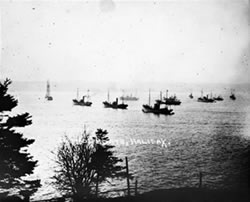First World War
The Royal Canadian Navy (RCN) would face a great test just four years after being formed. The First World War erupted in August 1914 and England declared war on Germany. Canada, as a member of the British Empire at the time, was automatically at war too. Canada’s young navy put to sea immediately — our country’s first military response in a war that would rage for more than four years.
The RCN began the war with only two ships and fewer than 350 men. There were modest patrols off the East and West coasts at the beginning of the conflict, but it was felt that the best way for Canada to contribute to the war effort was to send men to fight on the Western Front in Europe and leave the defence of our coasts to the navies of Britain and other Allies.
Canada’s navy expanded slowly, but eventually grew to 9,000 officers and men by the end of the First World War. Much of their efforts were devoted to organizing shipping, developing and defending ports, regulating patrols, monitoring wireless communications and providing support for British warships in nearby waters. The First World War saw German submarines (called ‘U-boats’) take a great toll on the Allied Merchant Navy ships carrying troops and desperately-needed supplies from North America to Europe. With this vital flow almost choked off, the Allies moved to the convoy system of placing merchant ships into large groups and escorting them across the ocean with warships for protection. Canadian and Newfoundland ports like Québec City, Saint John, Halifax and St. John’s became important convoy gathering points.
The RCN’s first real fleet consisted of smaller auxiliary ships — many of them converted yachts — that patrolled the Atlantic coast and the Gulf of St. Lawrence. The threat was real — U-boats came to our shores late in the war and sank several Canadian fishing trawlers and schooners off the East Coast.
The challenge was great, but Allied efforts at sea helped turn the tide and allowed enough war materials to make it through for the Allies to eventually win the war in late 1918. The RCN’s efforts would set the stage for greater contributions in the years to come. It would be scarcely 20 years before the world was again swept into an even larger war... a war in which Canada would find itself assuming a much greater role in fighting a skilled and dangerous enemy at sea.
Did You Know?
Some of Canada’s first warships were submarines! Two submarines were being built in Seattle, Washington for the Chilean Navy in 1914 when the deal fell through. The Premier of British Columbia, Sir Richard McBride, saw an opportunity to help build the young RCN on the eve of the First World War and moved to buy them for Canada. The purchase was ratified by the federal government and the two ships entered service as the CC1 and the CC2. They trained and cruised in the Pacific for three years before being sent to the East Coast via the Panama Canal in 1917. As it turned out, the ships were deemed no longer fit for service and remained in Halifax until being scrapped in 1920.
Related Links
- Date modified:

